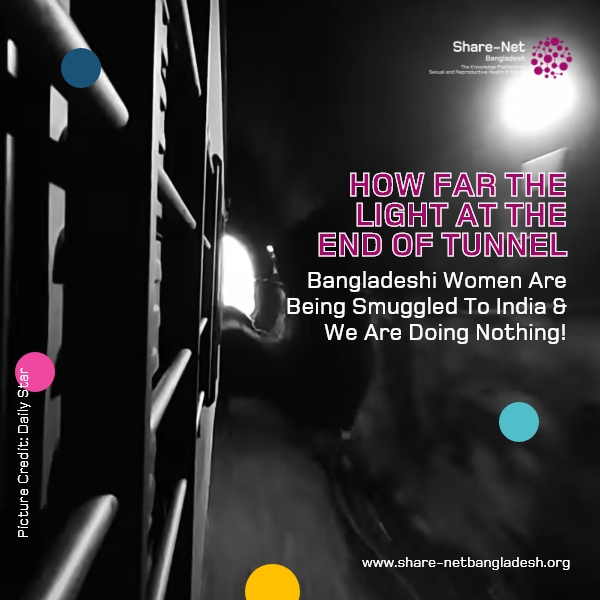How Far The Light At The End Of Tunnel: Bangladeshi Women Have Been Smuggling To India And We Doing Nothing?
“I can now speak five to six languages — Hindi, Marathi, Karnataka (Kannada), Gujarati, and Bangla,” says Pakhi, a Bangladeshi woman who was trafficked to India 15 years ago. Her linguistic versatility isn’t a point of pride, but a stark reminder of the years she spent trapped in Pune’s infamous red-light district, Budhwar Peth.
Pakhi’s story is just one chapter in the harrowing epic of sex trafficking from Bangladesh to India, a dark underworld where dreams of a better life are crushed beneath the weight of exploitation and abuse.
According to a recent investigation by The Daily Star, an estimated 200-250 Bangladeshi women and girls are currently trapped in the brothels of Budhwar Peth alone. This represents a staggering 20-25% of the area’s 800-900 sex workers, painting a grim picture of the scale of cross-border trafficking.
“We mainly found people crossing the border without passports for treatment purposes. Sometimes, we found trafficking victims and lawful action was taken,” says Khandker Shamim Uddin, officer-in-charge of Maheshpur police station. However, the investigation reveals a far more sinister reality lurking beneath official statements.
The journey often begins in poverty-stricken areas of Bangladesh. Joly Khatun, a survivor from Narail, recounts her horrific experience: “They put out cigarette butts on my thigh, my neck, and my back when I refused to agree on their proposal. Then they locked me up in a room and did not give me anything to eat for the next two days.”
The border between Bangladesh and India becomes a treacherous gateway for these women. Only 60% of the 4,096-kilometer-long border is fenced, leaving ample opportunity for traffickers to operate. In the first four and a half months of 2023 alone, the Border Guard Bangladesh’s Maheshpur Battalion apprehended 75 individuals attempting to enter India illegally.
Once in India, the nightmare intensifies. Women find themselves sold to brothels, their bodies commodified and their rights stripped away. A source in Mumbai, who has been aiding law enforcement in rescue operations since 2006, paints a chilling picture: “We witnessed girls aged between 11 and 14 years old being trafficked from Bangladesh, and the proportion is not less than 30 percent.”
The economics of this illicit trade are staggering. According to SM Azharul Islam, a program manager at Rights Jashore, the person who initially recruits a girl receives 15,000 Bangladeshi Taka (approximately $140 USD). By the time a girl reaches Mumbai, her “sale price” can reach 300,000 Taka ($2,800 USD).
Even more disturbing is the cycle of exploitation that perpetuates itself. Pakhi, once a victim, now manages her own brothel. “We are now saving money to ensure an identity in India,” she says, highlighting the complex web of survival and complicity that traps many women.
The response from authorities on both sides of the border is often inadequate, if not complicit. An anonymous additional superintendent of police from Khulna Range admits, “Actions are not taken against these traffickers as we receive benefits, tolls.”
For those who manage to escape or are “rescued,” the ordeal is far from over. Sumona’s story is a testament to the re-victimisation many face. Trafficked at a young age, she was arrested during a police raid and charged under the Immoral Traffic (Prevention) Act. Her attempts to seek justice and return home have been mired in legal complexities for years.
“The sad part is that no one is addressing the issues of the safety of women and girls during the transit, be it in Bangladesh or in India,” laments Tejaswi Sevekari, facilitator of Saheli, a sex workers’ collective in Pune. “A woman’s current status needs to be considered during the rescue operation. Most of the time, it happens without her consent.”
As we unravel the layers of this crisis, it becomes clear that sex trafficking is not just a criminal issue, but a fundamental violation of human rights, women’s rights, and sexual and reproductive health rights (SRHR). It undermines progress towards multiple Sustainable Development Goals, including gender equality and reduced inequalities.
Addressing this complex issue requires a multi-faceted approach. Stronger border security, international cooperation, and economic development in vulnerable communities are crucial. Equally important is a shift in how we view and treat survivors, prioritising their rights, dignity, and long-term well-being.
As Triveni Acharya, co-founder of Rescue Foundation, poignantly states, “Each woman trapped in this cycle of abuse represents a failure of our society to protect its most vulnerable.” It’s a failure we can no longer afford to ignore. The stories of Pakhi, Joly, Sumona, and countless others demand not just our attention, but our action. Only then can we hope to break the cycle of exploitation and create a world where no woman’s dreams are shattered at the border of hope and despair.
Source: The Daily Star
Source Contributor: Mohammad Jamil Khan (Dhaka), Shreya Raman (Mumbai)
Picture Credit:


